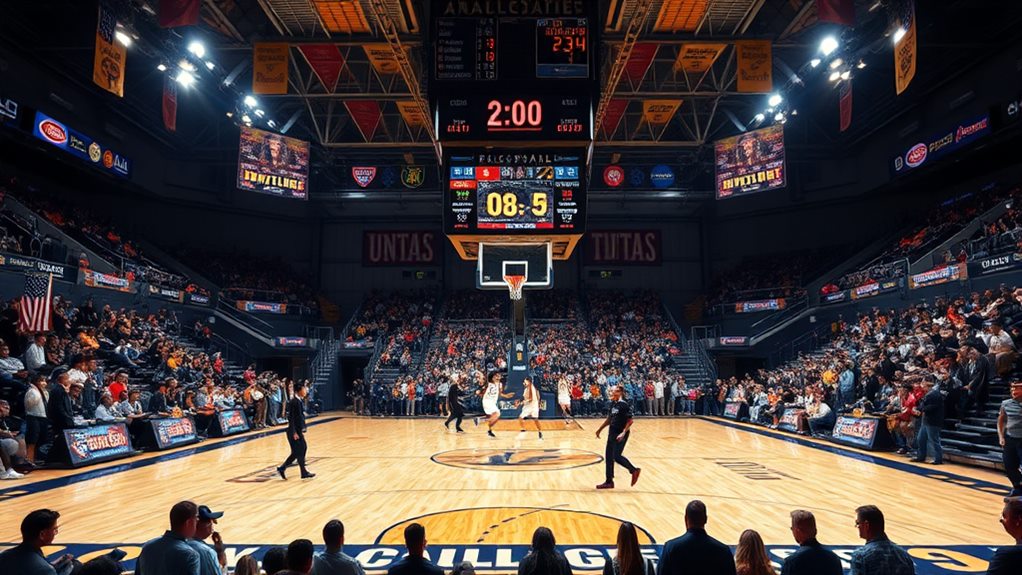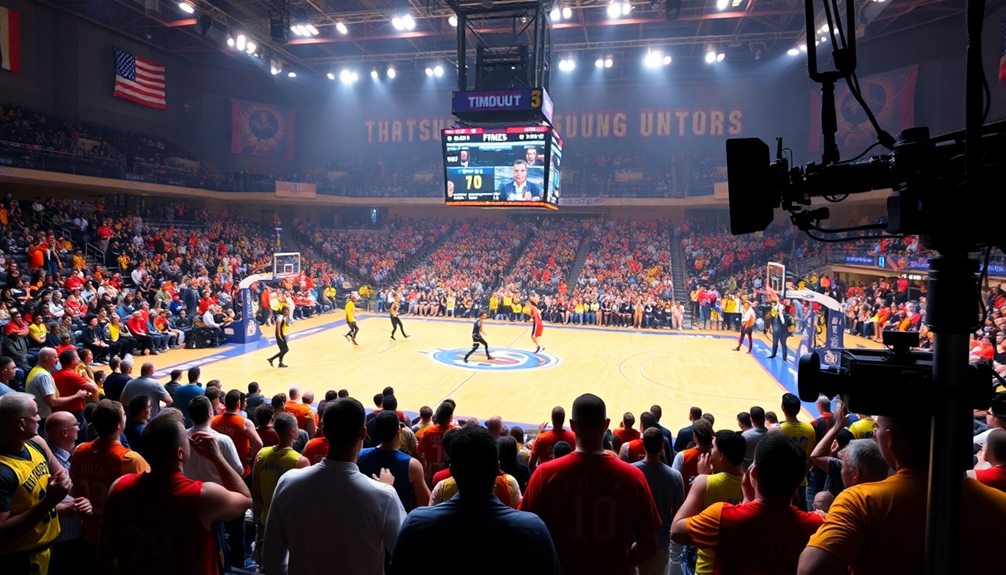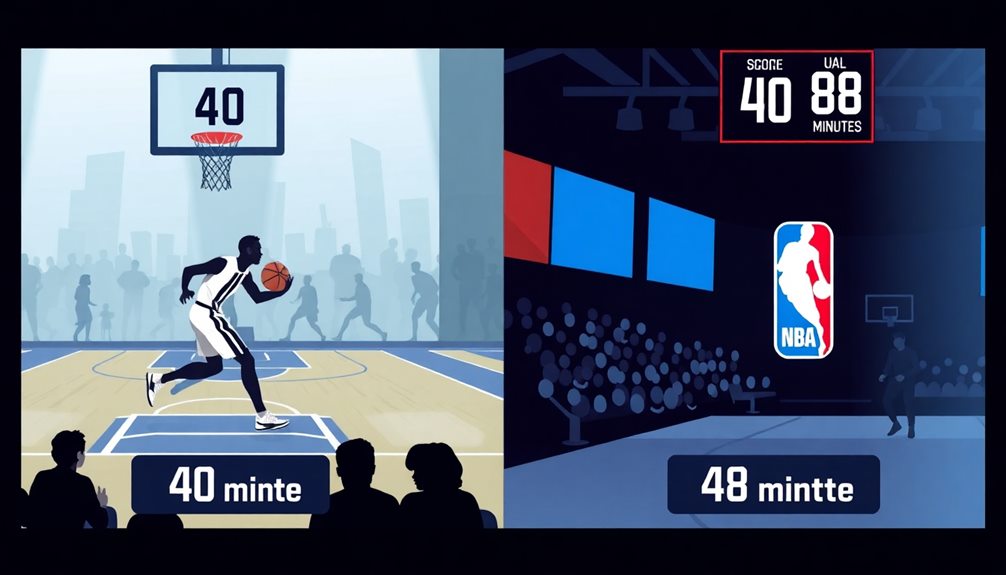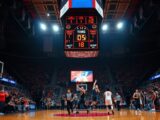
How Long Are College Basketball Games? Explained
December 12, 2024College basketball games are 40 minutes long, split into two 20-minute halves. However, when you factor in timeouts, halftime, and stoppages, the total game duration usually stretches to about two hours. Each team gets several timeouts, which can disrupt the flow of play. If the game goes into overtime, each extra period adds five minutes, potentially extending the game even further—sometimes up to three hours! With all these elements at play, understanding the full duration can enhance your appreciation for the excitement of college basketball. You might find yourself surprised by the nuances that affect game length.
Game Structure Overview
When it comes to college basketball, understanding the game's structure is essential for fans and players alike. College basketball games are divided into two halves, each lasting 20 minutes, which totals 40 minutes of regulation playtime. This structure mirrors the standard match duration seen in soccer, emphasizing the importance of time management and strategy.
After the first half, there's a 15-minute halftime break that allows teams to regroup, strategize, and refresh before diving back into the action.
If the score is tied at the end of regulation, the game moves into overtime periods, each lasting 5 minutes. Up to five overtime periods can be played, which adds excitement but also extends the total game time considerably.
You should also be aware that scheduled TV timeouts occur at specific intervals during each half, after the 16, 12, 8, and 4-minute marks. These stoppages, along with fouls and substitutions, contribute to the overall length of the game.
As a result, the total game time can exceed 2 hours, making the average duration around 2 to 2.5 hours. This game structure overview helps you appreciate the pacing and flow of college basketball.
Understanding Timeouts
In college basketball, each team gets four timeouts during regulation, including a mix of 60-second and 30-second breaks.
These timeouts not only give coaches a chance to strategize but also greatly affect the game's duration.
Additionally, understanding the timing regulations and the key regulations can enhance your viewing experience.
Understanding how these stoppages work can help you appreciate the pacing and flow of the match better.
Types of Timeouts
Have you ever wondered how timeouts affect the flow of a college basketball game? In college basketball, each team gets a total of four timeouts during regulation. This includes one 60-second timeout and three 30-second timeouts.
If your team doesn't use all of its timeouts in the first half, those unused seconds can carry over to the second half, giving you potentially two extra 30-second timeouts to strategize.
Besides team timeouts, there are also scheduled TV timeouts. These occur at the first dead ball after the 16, 12, 8, and 4-minute marks in each half, resulting in up to eight possible TV timeouts during a televised game.
If the game goes into overtime, each team earns one additional 30-second timeout, and any unused timeouts from regulation can still be called.
These timeouts, both team and TV, play a vital role in managing the tempo and strategy of the game. They create pauses in the action, allowing teams to regroup and coaches to make adjustments, ultimately impacting how the game unfolds.
Impact on Game Duration
Timeouts greatly influence the overall duration of college basketball games. Each team gets four timeouts during regulation play, consisting of one 60-second and three 30-second timeouts, which can alter the game's flow.
You'll notice that these stoppages, along with media timeouts scheduled for the first dead ball after the 16, 12, 8, and 4-minute marks, extend the game duration for broadcasting purposes. Unused timeouts can carry over into the second half, allowing teams to adjust their strategies as needed.
During overtime, teams receive an additional 30-second timeout, and any remaining timeouts from regulation can be utilized, further prolonging playing time. This means that even though the actual playtime is only 40 minutes, the average game experiences last between 2.5 to 3 hours.
Team fouls can also contribute to stoppages, leading to more timeouts and extended breaks in action. Ultimately, timeouts and their management are essential to understanding how they impact the game's overall duration.
Television Timeout Schedule

When you watch a college basketball game, you'll notice scheduled television timeouts happening at specific intervals—after the 16, 12, 8, and 4-minute marks in each half.
These breaks not only provide a chance for broadcasters to run ads but also impact the flow of the game, often leading to longer overall game times.
Understanding this schedule helps you anticipate when the action might pause, especially as teams utilize data analytics to optimize their performance during these breaks and adjust strategies accordingly, enhancing team performance.
Scheduled Timeout Intervals
In college basketball games, scheduled television timeouts play an essential role in managing the flow of the match. These scheduled TV timeouts occur at the first dead ball after the 16, 12, 8, and 4-minute marks in each half.
You'll notice that if a team calls a timeout within 30 seconds of a scheduled TV timeout, it counts as that scheduled timeout. This rule helps to minimize additional stoppages and keeps the game moving.
Video reviews also fall under this regulation; if they happen within the same 30-second window, they convert into a TV timeout. This system not only limits interruptions but also gives teams a chance to strategize and regroup during the game.
With a total of eight TV timeouts available for televised college basketball games, networks benefit from enhanced advertising opportunities.
These scheduled television timeouts are crucial for both broadcasters and teams, ensuring that the game flows smoothly while providing essential moments for teams to discuss tactics and make adjustments.
Whether you're watching or playing, understanding these intervals enhances your appreciation for the game.
Impact on Game Flow
The rhythm of a college basketball game can be greatly influenced by the scheduled television timeouts. These timeouts, strategically placed throughout the game, can impact players' momentum and game flow. Here's how they affect the game:
- Scheduled Timeouts: Occur at the first dead ball after the 16, 12, 8, and 4-minute marks in each half.
- Total TV Timeouts: Each game can incorporate up to eight TV timeouts for broadcasting and advertising purposes.
- Team Timeouts: If a team calls a timeout within 30 seconds of a scheduled TV timeout, it counts as that timeout, reducing interruptions.
- Video Reviews: Similar to team timeouts, video reviews within 30 seconds of a TV timeout also count as a TV timeout.
These interruptions can extend the overall game duration and disrupt the rhythm of the game. Players may struggle to maintain their momentum due to these extended breaks in play.
While these timeouts serve essential broadcasting and advertising needs, they can considerably alter the flow and pace of the game, leaving fans and players alike feeling the impact.
Impact of Overtime
Overtime in college basketball can dramatically alter the course of a game, adding intensity and excitement as teams battle for victory. Each overtime period lasts 5 minutes, and if the score remains tied after the first, additional overtime periods can be played. The maximum number of overtime periods is five, which can considerably extend the total game length.
In fact, if teams are evenly matched, a game can stretch well beyond the typical two hours, pushing it to three hours or more. During these critical moments, teams must exhibit exceptional player conduct and teamwork to navigate the high-pressure environment effectively.
During these critical moments, teams have one 30-second timeout per overtime period. This timeout can be a game-changer, allowing coaches to devise strategies to capitalize on the situation. Players often need to adjust their approaches, whether it's focusing on defensive plays or executing a game-winning shot.
Overtime not only tests a team's skill and endurance but also their mental toughness and strategic planning. As the clock ticks down, every possession counts, making the atmosphere electric.
Game Duration Comparisons

When comparing game durations across different levels of basketball, you'll notice some distinct differences. College basketball games consist of two halves, totaling 40 minutes of regulation play. However, with stoppages and timeouts, the actual game duration typically spans around 2 hours.
The evolution of racial diversity in basketball has also influenced the game, as the unique playing styles brought by players of diverse backgrounds have added dynamic elements to the sport. Here's how it stacks up against other formats:
- NCAA Tournament: Similar to regular college games, but the stakes can lead to longer durations due to emotional timeouts and potential overtime periods.
- NBA Games: These last 48 minutes, divided into four 12-minute quarters, usually resulting in an average duration of about 2 hours and 15 minutes, thanks to frequent TV timeouts.
- High School Basketball: With four 8-minute quarters, these games are shorter, generally lasting between 1.5 to 2 hours, making them the quickest option among the three.
- Overtime Periods: In college, if a game ends in a tie, a 5-minute overtime can greatly extend the game, adding to its overall duration.
Understanding these differences helps you appreciate the unique pacing of each level of play in basketball, especially as the sport continues to embrace historical shifts in racial diversity.
Factors Affecting Game Length
Several factors contribute to the overall length of college basketball games beyond the 40 minutes of actual play. College games consist of two halves, each lasting 20 minutes, but the actual game duration can easily exceed 2 hours. This is mainly due to stoppages and timeouts, which are essential for maintaining fair play and ensuring player safety, much like the foundational principles of the YMCA that emphasize holistic development.
Each team is allowed four timeouts during regulation play, and scheduled TV timeouts also occur at specific intervals, adding extra time to the game.
Fouls are another key factor affecting game length. When players commit fouls, it can lead to free throws, which not only disrupt the flow of the game but also extend the time spent on the court.
Additionally, if the score is tied at the end of regulation, overtime periods come into play, each lasting 5 minutes. Depending on how many overtimes are needed, this can greatly increase the total game length, with a maximum of five overtimes allowed.
Considering all these elements—timeouts, stoppages from fouls, and potential overtime—the total game experience can last anywhere from 2.5 to 3 hours. So, when you plan to watch a college basketball game, be ready for a longer commitment!
Conclusion
To sum up, college basketball games pack plenty of pulsating action, typically lasting around two hours, but factors like timeouts and overtime can stretch that time. You'll find the thrill of the game is sprinkled with strategic pauses and broadcasting breaks. Whether you're a casual fan or a die-hard devotee, knowing the game's timeline helps you better enjoy the exciting experience. So, grab your gear, gather your friends, and get ready for some exhilarating entertainment!


